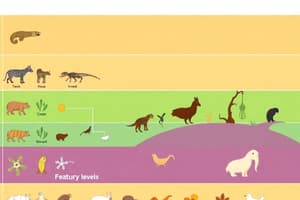Podcast
Questions and Answers
How are organisms hierarchically classified based on evolutionary relationships?
How are organisms hierarchically classified based on evolutionary relationships?
- Based on their color
- Based on their differences and similarities (correct)
- Based on their habitat
- Based on their size
What is the reason for changes in how organisms are classified?
What is the reason for changes in how organisms are classified?
New classification sets are found, or new information is discovered about that organism.
How did scientists infer relationships among organisms for classification purposes using observation?
How did scientists infer relationships among organisms for classification purposes using observation?
Similar organisms look similar, helping relate them to each other.
What are the distinguishing characteristics of Domain Bacteria?
What are the distinguishing characteristics of Domain Bacteria?
What are the distinguishing characteristics of Domain Eukarya?
What are the distinguishing characteristics of Domain Eukarya?
What are the distinguishing characteristics of Domain Archaea?
What are the distinguishing characteristics of Domain Archaea?
What are the distinguishing characteristics of Kingdom Animalia?
What are the distinguishing characteristics of Kingdom Animalia?
What are the distinguishing characteristics of Kingdom Fungi?
What are the distinguishing characteristics of Kingdom Fungi?
What are the distinguishing characteristics of Kingdom Plantae?
What are the distinguishing characteristics of Kingdom Plantae?
What are the distinguishing characteristics of Kingdom Protista?
What are the distinguishing characteristics of Kingdom Protista?
What are the distinguishing characteristics of Kingdom Archaea?
What are the distinguishing characteristics of Kingdom Archaea?
What are the distinguishing characteristics of Kingdom Bacteria?
What are the distinguishing characteristics of Kingdom Bacteria?
Flashcards are hidden until you start studying
Study Notes
Organism Classification
- Organisms are classified based on evolutionary relationships using a hierarchical system: Domain, Kingdom, Phylum, Class, Order, Family, Genus, Species.
- Classification is influenced by similarities and differences among organisms.
Changes in Classification
- Classification can change due to discovery of new classification sets or new information about organisms.
Observations for Classification
- Similar appearances among organisms can indicate evolutionary relationships.
Domain Bacteria Characteristics
- Composed of prokaryotic cells.
- Contains unique ribosomal RNA (rRNA) specific to bacteria.
Domain Eukarya Characteristics
- Comprised of eukaryotic cells.
- Not all members possess cell walls.
- Resistant to antibacterial antibiotics.
- Features unique ribosomal RNA specific to Eukarya.
Domain Archaea Characteristics
- Consists of prokaryotic cells.
- Contains unique ribosomal RNA (rRNA) exclusive to Archaea.
- Resistant to some antibiotics affecting Bacteria, but sensitive to certain antibiotics that target Eukarya.
Kingdom Animalia Characteristics
- Multicellular, eukaryotic, and heterotrophic organisms.
- Develop from embryos.
- Estimated to contain 9 to 10 million species.
- Capable of complex movements.
Kingdom Fungi Characteristics
- Eukaryotic and primarily decomposers.
- Lack chlorophyll and are mostly multicellular.
- Non-motile and more closely related to animals than plants.
- Lack true roots, leaves, and stems, absorbing nutrients post-digestion.
- Not dependent on light for growth.
Kingdom Plantae Characteristics
- Composed of multicellular, autotrophic eukaryotes.
- Engage in photosynthesis and contain membrane-bound organelles.
- Important food source for many organisms.
- Most possess chlorophyll and grow by cell division.
Kingdom Protista Characteristics
- Includes simple eukaryotic organisms.
- Can be heterotrophic or autotrophic.
- Primarily inhabit aquatic environments.
- Movement facilitated by flagella or cilia.
Kingdom Archaea Characteristics
- Consists of single-celled microorganisms.
- Prokaryotic in nature.
Kingdom Bacteria Characteristics
- Comprised of prokaryotic cells with cell walls that contain peptidoglycans.
- Unicellular and can be either autotrophic or heterotrophic.
Studying That Suits You
Use AI to generate personalized quizzes and flashcards to suit your learning preferences.




